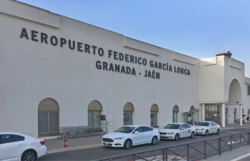Granada-Jaen Airport
| Aeropuerto Federico García Lorca de Granada-Jaén | |
|---|---|

|
|
| Characteristics | |
| ICAO code | LEGR |
| IATA code | GRX |
| Coordinates | |
| Height above MSL | 567 m (1860 ft ) |
| Transport links | |
| Distance from the city center | 16 km west of Granada , 64 km south of Jaén |
| Street |
|
| Local transport | bus |
| Basic data | |
| opening | 1972 |
| operator | Aena |
| Terminals | 1 |
| Passengers | 1,126,417 (2018) |
| Air freight | 0.336 t (2018) |
| Flight movements |
13,618 (2018) |
| Capacity ( PAX per year) |
2.2 million |
| Start-and runway | |
| 09/27 | 2900 m × 45 m asphalt |
The Granada-Jaén Airport ( Spanish Aeropuerto Federico García Lorca de Granada-Jaén , Aeropuerto FGL for short ) is a commercial airport in the province of Granada ( Spain ) in the south of the Iberian Peninsula . It is located in the Andalusia region about 16 km west of the city of Granada and about 64 km south of Jaén .
history
The location of today's Granada Airport has only existed since the early 1970s. However, aviation in the province of Granada dates back to 1895, when the first balloon flights took place in the area of the suburb of Armilla in the south-west of Granada. During the "Feria del Corpus de Granada" in 1911, the first flight festival was held, which was repeated several times in the following years, with interruptions during the First World War.
The unrest that broke out in Spanish Morocco shortly afterwards in 1921 led to the official opening of a military airfield on the grounds of the flight festival in 1922 , which was named Aeródromo Dávila in 1925 , after a pilot who had an accident that year. After the end of the uprising, the airfield became a civil airfield, the first connection of which was to Seville in 1929 . After only one year, the line was discontinued and the square was used again for military purposes , even during the civil war .
Civil flight operations began a second time in 1946 and as the number of passengers increased due to the emerging tourism , the infrastructure was expanded in the 1950s. However, this did not include a paved runway.
The emergence of jet air traffic in the 1960s led to the construction of a new airport between the villages of Chauchina and Santa Fe, which opened in 1972 after a two-year construction period and has since handled civilian flight operations. The military remained at the old location and still uses the location as a base area de Armilla , in particular as a heliport for Ala 78 (78th squadron).
In the run-up to the Alpine World Ski Championships in 1996 in the Sierra Nevada , today's airport was modernized and expanded and on June 13, 2006 it was named Federico García Lorca Granada-Jaén , in memory of Federico García Lorca .
meaning
In the passenger statistics of all Spanish airports, Granada-Jaén Airport recorded 1,126,417 passengers in 2018. In the ranking of the airports in Andalusia , it ranks fourth after Málaga , Seville and Jerez , ahead of Almería and Córdoba .
Traffic figures

| year | Passenger volume | Air freight ( tons ) | Flight movements |
|---|---|---|---|
| 2018 | 1,126,417 | 0.336 | 13,618 |
| 2017 | 901.967 | 1.291 | 12,539 |
| 2016 | 751.287 | 6,901 | 11,333 |
| 2015 | 707.270 | 0.990 | 11,089 |
| 2014 | 650,542 | 3,589 | 10,348 |
| 2013 | 638.288 | 12.636 | 10,563 |
| 2012 | 728.428 | 27.933 | 11,376 |
| 2011 | 872.752 | 34,472 | 13,142 |
| 2010 | 978.254 | 37.889 | 13,843 |
| 2009 | 1,187,813 | 41.150 | 16,300 |
| 2008 | 1,422,014 | 66.889 | 19,279 |
| 2007 | 1,467,625 | 72,443 | 21,822 |
| 2006 | 1,086,236 | 69.554 | 17,583 |
| 2005 | 875.827 | 65.871 | 15,746 |
| 2004 | 590.931 | 85.891 | 13,584 |
| 2003 | 525,869 | 101,201 | 12,804 |
| 2002 | 486.756 | 95.415 | 11,188 |
| 2001 | 514.966 | 121.419 | 10,444 |
| 2000 | 509,442 | 120.676 | 9,906 |
Web links
- Official airport website (English, Spanish)
- Official website of the operator (English, Spanish)
- Airport data on World Aero Data